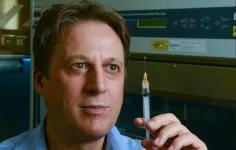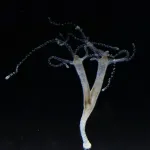(Press-News.org) Somnambulism - otherwise known as sleepwalking - is a phenomenon which has fascinated the public and neurologists for decades, but a lot of what causes it remains a mystery.
Affecting up to 4% of adults, sleepwalking is a non-rapid-eye movement (NREM) sleep parasomnia that not only gives someone a poor night's sleep, but also puts them at serious risk of injury and, in some cases, lead to unintended violence against others.
The following day can also prove challenging as the sleepwalker will feel unrested and a strong desire to fall asleep (somnolence).
Unfortunately for those predisposed to sleepwalking episodes, prolonged sleep deprivation increases both their frequency and complexity, making it harder for them to achieve the deep sleep the body needs to function healthily.
Now, in a paper published to Frontiers in Neurology, researchers at the University of Montréal and Montréal Sacred Heart Hospital, Canada aimed to further investigate the hypothesis that sleepwalking is a disorder of arousal and poorly regulated deep sleep (slow-wave sleep).
More specifically, they examined how the autonomic nervous system - measured via the heart rate - influences deep sleep in sleepwalkers.
Challenges of a sleepwalking study
14 adult sleepwalkers were recruited for the study as well as 14 sex- and age-matched normal controls. They were evaluated using video-polysomnography for one night and during recovery sleep following 25 hours of sleep deprivation.
According to corresponding authors Prof Antonio Zadra and Dr Andrée-Ann Baril of the University of Montréal, it can be a challenge to put together a study investigating the mysterious inner workings of sleepwalking.
"One challenge in studying large cohorts of sleepwalkers is the relatively low prevalence of the disorder in the adult population," they said.
"Fortunately, the Center for Advanced Research in Sleep Medicine, where this research was conducted, is a one-of-a-kind clinical and research facility in Canada affiliated with one of the country's largest and highly specialized sleep disorders clinics that assesses over 1,000 patients a year. As a general rule, however, adult sleepwalkers are readily willing to take part in research studies aiming to better understand the underlying causes and possible treatments of the sleep disorder."
Wakefulness and deep sleep at the same time
The autonomic nervous system regulates the body's physiological functions and is composed of the sympathetic branch, which underlies the 'fight or flight' response, and the parasympathetic branch, which underlies the 'rest and digest' response. Zadra, Baril, and the rest of their team found that sleepwalkers show an elevated rest-and-digest response and a lower fight-or-flight response during deep sleep.
"While the causes of sleepwalking remain unclear, we know that while asleep, sleepwalkers can experience an abnormal interplay between processes linked to arousal and to deep sleep, even outside of their episodes," Zadra and Baril said.
"In other words, sleepwalkers can present evidence of both wakefulness and deep sleep at the same time; a state out of which episodes of sleepwalking can arise. Our findings indicate that when compared to healthy adults, sleepwalkers' autonomic nervous system favors their parasympathetic activity, or rest-and-digest response, during sleep. This paves a new and broader way to understand the biological processes implicated in sleepwalking."
Surprising discovery
The results were "surprising", they added, as it had been assumed that the deep sleep of sleepwalkers would show an elevated fight-or-flight response that would predispose them to higher risks of experiencing sleepwalking episodes.
One limitation of the study is that measuring the influence of the sympathetic and parasympathetic branches on a person's heartbeat is an indirect approach and can be confounded by other factors.
"While our results indicate the presence of an altered autonomic nervous system during sleepwalkers' deep sleep, whether and how this atypical activity is involved in the occurrence of actual sleepwalking episodes remains to be determined," Zadra and Baril said.
"Since several pharmaceutical agents can be used to modulate autonomic effects, such treatment venues could be explored if our results are replicated and expanded upon."
INFORMATION:
Pioneering research, led by a team from Trinity College Dublin and the Marine Research Institute of the Spanish Research Council (IIM-CSIC) in Vigo (Galicia, Spain), suggests "subterranean estuaries" may be critical in managing sustainable fishing and aquaculture - two growing industries of global importance.
Subterranean estuaries are analogous to surface water estuaries, where freshwater flowing out to sea mixes with seawater, but are instead located underground, invisible to the naked eye. Yet the newly published research shows these hidden features are very important in the ecology of coastal systems and in filtering pollutants - some of which ...
The cultivated planet is withstanding record-breaking pressure to ensure food security. To meet the rising demand of food, energy, and fiber, a 70%-100% increase in crop commodities will be needed globally by 2050. However, rapid urbanization and industrialization have caused dramatic loss of high-quality cropland and hence threatened food security. To stabilize cropland area, cropland expansion to marginal lands has become a widespread phenomenon worldwide. This study developed a systems framework to represent the trade-off among crop yield, production, and environmental cost, according to the competitive relationship of production, settlement, and ecological space and the link of "land - food - environment - policy". Using China as a case study, the authors ...
The rarity of these syndromes, caused by damage to a gene named HUWE1, means very few children are affected. Of course, the low absolute numbers are little consolation for children who are born with a severe intellectual disability as a result of gene mutation.
Many affected children have distinctive facial features, some struggle to learn to walk, and many never learn to speak. Some have an abnormally small head and have stunted growth.
There is no cure. Parents mainly focus on learning enough about how to cope to make everyday life workable.
A lot ...
A study from the Centre for Nutraceuticals at the University of Westminster found that plant-based protein shakes may be potential viable alternatives to milk-based whey protein shakes, particularly in people with need of careful monitoring of glucose levels.
The study, published in the journal Nutrients, is the first to show potato and rice proteins can be just as effective at managing your appetite and can help better manage blood glucose levels and reduce spikes in insulin compared to whey protein.
During the study the blood metabolic response of participants was measured after ...
New research has uncovered a novel trick employed by the bacterium Staphylococcus aureus to thwart the immune response, raising hopes that a vaccine that prevents deadly MRSA infections is a little closer on the horizon.
Immunologists from Trinity College Dublin, working with scientists at GSK - one of the world's largest vaccine manufacturers - discovered the new trick of the troublesome Staphylococcus aureus, which is the causative agent of the infamous "superbug" MRSA.
They found that the bacterium interferes with the host immune response by causing toxic effects on white blood cells, which prevents them from engaging in their infection-fighting jobs.
Importantly, the study also showed in a pre-clinical ...
Scientists using computer modelling to study SARS-CoV-2, the virus that caused the COVID-19 pandemic, have discovered the virus is most ideally adapted to infect human cells - rather than bat or pangolin cells, again raising questions of its origin.
In a paper published in the Nature journal Scientific Reports, Australian scientists describe how they used high-performance computer modelling of the form of the SARS-CoV-2 virus at the beginning of the pandemic to predict its ability to infect humans and a range of 12 domestic and exotic animals.
Their work aimed to help identify any intermediate animal vector that ...
Although IAT is commonly performed, there is variation in how, why, and where it is done. EULAR aimed to help standardise the way IAT is delivered, and explain to people what they can expect from the treatment. A EULAR taskforce was set up to develop a set of new recommendations to give guidance and advice on best practice for IAT.
The taskforce included doctors, nurses, surgeons, and other health professionals, as well as patients. The taskforce looked at the evidence on IAT. Because there is little published evidence, the taskforce also conducted two surveys ...
Russia is the world's largest forest country. Being home to more than a fifth of forests globally, the country's forests and forestry have enormous potential to contribute to making a global impact in terms of climate mitigation. A new study by IIASA researchers, Russian experts, and other international colleagues have produced new estimates of biomass contained in Russian forests, confirming a substantial increase over the last few decades.
Since the dissolution of the USSR, Russia has been reporting almost no changes in its forests, while data obtained ...
In the animal kingdom, specific growth factors control body axis development. These signalling molecules are produced by a small group of cells at one end of the embryo to be distributed in a graded fashion toward the opposite pole. Through this process, discrete spatial patterns arise that determine the correct formation of the head-foot axis. A research team at the Centre for Organismal Studies (COS) at Heidelberg University recently discovered an enzyme in the freshwater polyp Hydra that critically shapes this process by limiting the activity of certain growth factors.
In particular, the proteins of the so-called Wnt signalling pathway play an important role in the pattern formation of the primary ...
MINNEAPOLIS/ST. PAUL (06/24/2021) -- A study led by researchers at the University of Minnesota Medical School sheds new light on boys' weapon-carrying behaviors at U.S. high schools. The results indicate that weapon-carrying is not tied to students' race or ethnicity but rather their schools' social climates.
The study was published in the journal Pediatrics and led by Patricia Jewett, PhD, a researcher in the Department of Medicine at the U of M Medical School.
"Narratives of violence in the U.S. have been distorted by racist stereotyping, portraying male individuals of color as more dangerous than white males," Jewett said. "Instead, our study suggests that school climates may be linked to an increase in weapon-carrying at schools."
The ...



